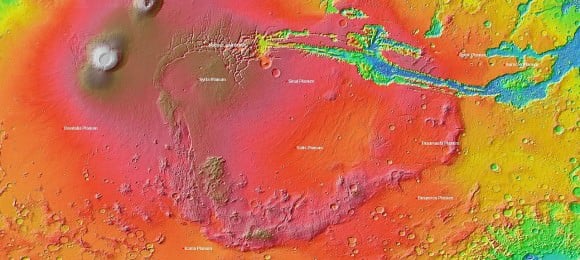"What happened to Mars?" is one of the most compelling questions in space science. It probably wasn't always the dead, dry, cold place it is now. Did its core cool and stop rotating, allowing the full glare of the sun to blast away its atmosphere and water, and kill anything that may have lived there? Was it struck by a large body, which incinerated its atmosphere, and led to its demise? Were there other causes?
According to a new research paper from Sylvain Bouley at the University of Paris-South, and his colleagues, it may have been a massive, ancient outpouring of molten rock that threw Mars off kilter and helped change Mars into what it is today.
The
Tharsis
region is an ancient lava complex on Mars that dates back to between 4.1 billion and 3.7 billion years ago. It's located in Mars' Western Hemisphere, right near the equator. It's made up of three huge shield volcanoes—Arsia Mons, Pavonis Mons, and Ascraeus Mons. Collectively, they're known as Tharsis Montes. (Olympus Mons, the largest volcano in the Solar System, is not a part of the Tharsis complex, though it is near it.)
Tharsis is over 5,000 km across and over 10 miles thick, making it the largest volcanic complex in the Solar System. That much mass positioned after Mars was already formed and had an established rotation would have been cataclysmic. Think what would happen to Earth if Australia rose up 10 miles.
[caption id="attachment_127681" align="alignnone" width="580"]
An image of the Syria-Thaumasia region of the Tharsis complex, showing the volcano Arsia Mons on the left, and Valles Marineris on the northern edge. Brown areas are the highest altitude. Open Source Image: Arizona State University, JMars.[/caption]
The new paper, published on March 2nd, 2016, in the journal Nature, says that the position of the Tharsis complex would have initiated a
True Polar Wander
(TPW.) Basically, what this means is that Tharsis' huge mass would have forced Mars to shift its rotation, so that the location of Tharsis became the new equator.
It was thought that the emergence of Tharsis made Martian rivers—which formed later—flow the direction they do. But the study from Bouley and his colleagues shows that Martian rivers and valleys formed first—or maybe concurrently—and that the Tharsis TPW deformed the planet later.
The authors of the study calculated where the Martian poles would have been prior to Tharsis, and looked for evidence of polar conditions at those locations. The location of this ancient north pole contains a lot of ice today, and the location of the ancient south polar region also shows evidence of water.
What it all adds up to is that the disappearance of water on Mars probably happened at the same time as the TPW. Whether the appearance of the Tharsis lava complex, and the resulting cataclysmic shifting of Mars' rotational orientation, were the cause of Mars losing its climate is not yet known for sure. But this study shows that the ancient volcanic cataclysm did at least help shape Mars into what it is today.
 Universe Today
Universe Today

